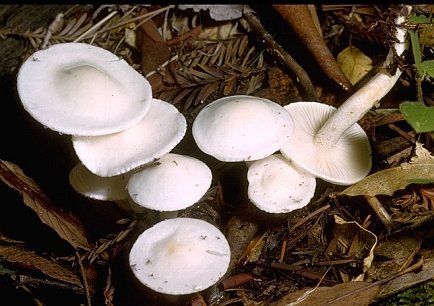The ivory waxcap, Hygrophorus eburneus (Bull.) Fr.
Synonyms
Agaricus eburneus Bull.
Gymnopus eburneus (Bull.) Gray
Hygrophorus cossus sensu auct.; fide Checklist of Basidiomycota of Great Britain and Ireland (2005)
Hygrophorus eburneus (Bull.) Fr.
Limacium eburneum (Bull.) P. Kumm.
Common names
White hygrophor
White waxy-cap
Ivory woodwax
Ivory wax(y)cap
Cowboy’s handerchief
Goat-moth
Elfenbeinschneckling (German)
Description
Cap: 3-7 cm broad, convex with an inrolled margin, expanding to nearly plane with a low umbo or the disc depressed with an upturned margin; surface smooth to silky, slimy-viscid, white, occasionally faintly yellow in age.
Flesh: white, soft, thick at the disc, thin elsewhere, unchanging; odor and taste mild.
Gills: subdecurrent to decurrent, subdistant, moderately broad, waxy, white, sometimes faintly yellow in age.
Stipe: 4-10 cm tall, 0.5-1.5 cm thick, equal to tapering towards the base, often bent, stuffed, becoming hollow at maturity; surface finely scaled at the apex, smooth below, white, viscid; veil absent.
Spores: 6.5-8 x 3.5-5 µm, smooth, elliptical.
Spore print: white.
Habitat: solitary to subgregarious in hardwood and conifer woods; fruiting in Sept.-Oct. Widespread in Europe and North America.
Medicinal properties
Bactericidal/fungicidal activity
Eight unusual fatty acids with bactericidal and fungicidal activity have been isolated from Hygrophorus eburneus (Teichert et al., 2005). These fatty acids, which all contain a so-called γ-crotonate partial structure, are named as follows:
(2E,9E)-4-oxooctadeca-2,9,17-trienoic acid
(2E 11Z)-4-oxooctadeca-2,11,17-trienoic acid
(E)-4-oxohexadeca-2,15-dienoic acid
(E)-4-oxooctadeca-2,17-dienoic acid
(2E, 9E)-4-oxooetadeca-2,9-dienoic acid
(2E, 11Z)-4-oxooetadeca-2,1 I-dienoic acid
(E)-4-oxollexadec-2-enoic acid
(E)-4-oxooctadec-2-enoic acid
Elemental composition
A recent study from Greece analyzed the metal contents of eight indigenous mushroom species, including H. eburneus. The metal concentrations, given as µg/g, dry weight basis, are summarized in the table below (mean ± standard deviation):
| Mg | Cr | Mn | Fe | Co | Ni | Cu | Zn | Pb | Cd | |
| H. eburneus | 1011±49.5 | 8.07±0.41 | 100±5.0 | 193±9.4 | 3.34±0.15 | 10.1±0.50 | 16.0±0.8 | 82.6±4.4 | 1.37±0.01 | 0.31±0.01 |
| 1 serving | 30.33±1.5 | 2.042±0.01 | 3.000±0.15 | 5.79±0.28 | 0.100±0.01 | 0.303±0.01 | 0.480±0.02 | 2.48±0.13 | 0.041±0.00 | 0.009±0.00 |
To help give these values more significance, the second row of the table gives the daily metal intakes by a normal 60 kg consumer, in mg/serving (assuming a serving size of 30 g, dry weight). The authors conclude that the intake of potentially toxic heavy metals (i.e. Pb, Cd and As) by consumption of 30 grams of H. eburneus (dry weight) poses no risk for the consumer. Furthermore, this mushroom can be used in a well-balanced diet due to the high contents of functional minerals (Ouzouni et al., 2007).

My name is Austin Collins.
I've dedicated my life to Mushrooms.
I believe Mushrooms are the best kept secret when it comes to health and well being.
For that reason, I would like to share a company with you that in my opinion makes the best mushroom products on the market.
The company is called Noomadic Herbals, my favorite supplement they make is called "Mushroom Total".
I take their products every day and they have helped me think better and have more energy. Give them a try.
-Austin
California fungi has links to several more pictures.
Ouzouni PK, Veltsistas, PG, Paleologos, EK, Riganakos, KA.
Determination of metal content in wild edible mushroom species from regions of Greece.
J Food Comp Anal. 2007 20(6):480-6.
Teichert A, Lubken T, Schmidt J, Porzel A, Arnold N, Wessjohann L.
Unusual bioactive 4-oxo-2-alkenoic fatty acids from Hygrophorus eburneus.
Z. Naturfors B:Chem Sci. 2005 60(1):25-32.



